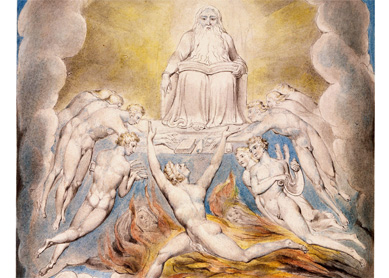When do we start seeing Satan used as a proper name and not a title?
So throughout the Hebrew Bible, we have a few different places where we see a figure called “the satan,” and the satan in Hebrew—we have a definite article the and satan is like a job title; it refers to the accuser. And the authors who use the satan motif are sort of picturing the god of the Hebrew Bible as presiding over a divine council. So you see this in the book of Job, for example, where the satan is kind of like the loyal opposition in a parliamentary system. God says, “Oh, have you seen my servant Job?” And the satan says, “Yes. I’ve seen your servant Job, you know, when I’m out wandering the earth.” And God says, “Isn’t he the most righteous, upright man you’ve ever seen?” And the satan points out to God that, “Well, he’s only loyal and upright and righteous because you give him everything.” And God says, “No, no, no. I gave him everything because he’s good, he’s righteous.” And the satan says, “Well, I bet you that if you took everything away from him, he wouldn’t be so good.” And so he’s kind of the voice of opposition, the accuser as he’s often translated. But it’s a job title; it’s not a proper name. And you see this in a few other places in the Hebrew Bible. The book of Numbers, in chapter 22, which features a talking donkey. The donkey isn’t the satan either, but actally the satan stops the donkey from moving forward on his way, and he’s sent by God.
And so the accuser seems to be sort of the figure who is acting as a member of God’s divine council who’s acting on God’s behalf and making sure that the humans kind of stay in line a little bit. And, of course, that’s not the way that we think of Satan. It becomes a name only in post Hebrew Bible literature, and in the couple of centuries before the New Testament is written, we start to see a shift in the way that Jews are thinking about good and evil and God and the theodicy, the justice of God, and part of that shift—there’s a lot of different reasons for it—but part of that shift seems to be kind of move the blame from humans for their behavior to some outside influence that’s kind of acting on humans, and then you have all kinds of names for the leader of the devil, sorry, the devil, the leader of the demons, and you’ve got demons versus angels. You have none of this in the Hebrew Bible. It all comes out in a second and first century BCE literature, and it finds its way into the New Testament as well, and sometime in the second/first century BCE, you start to see the term satan from the Hebrew Bible becoming a proper name in this literature and being sort of the proper name for the prince of darkness, as the New Testament calls him.


